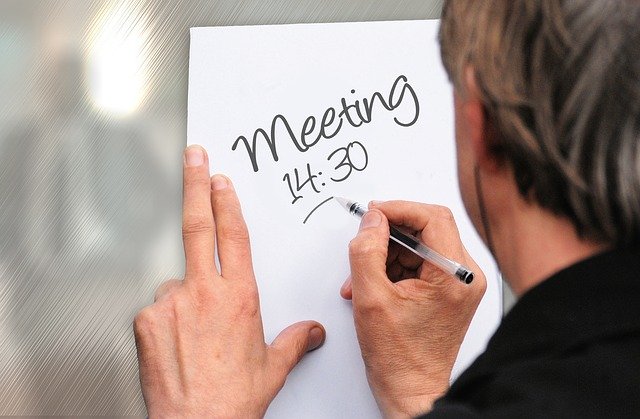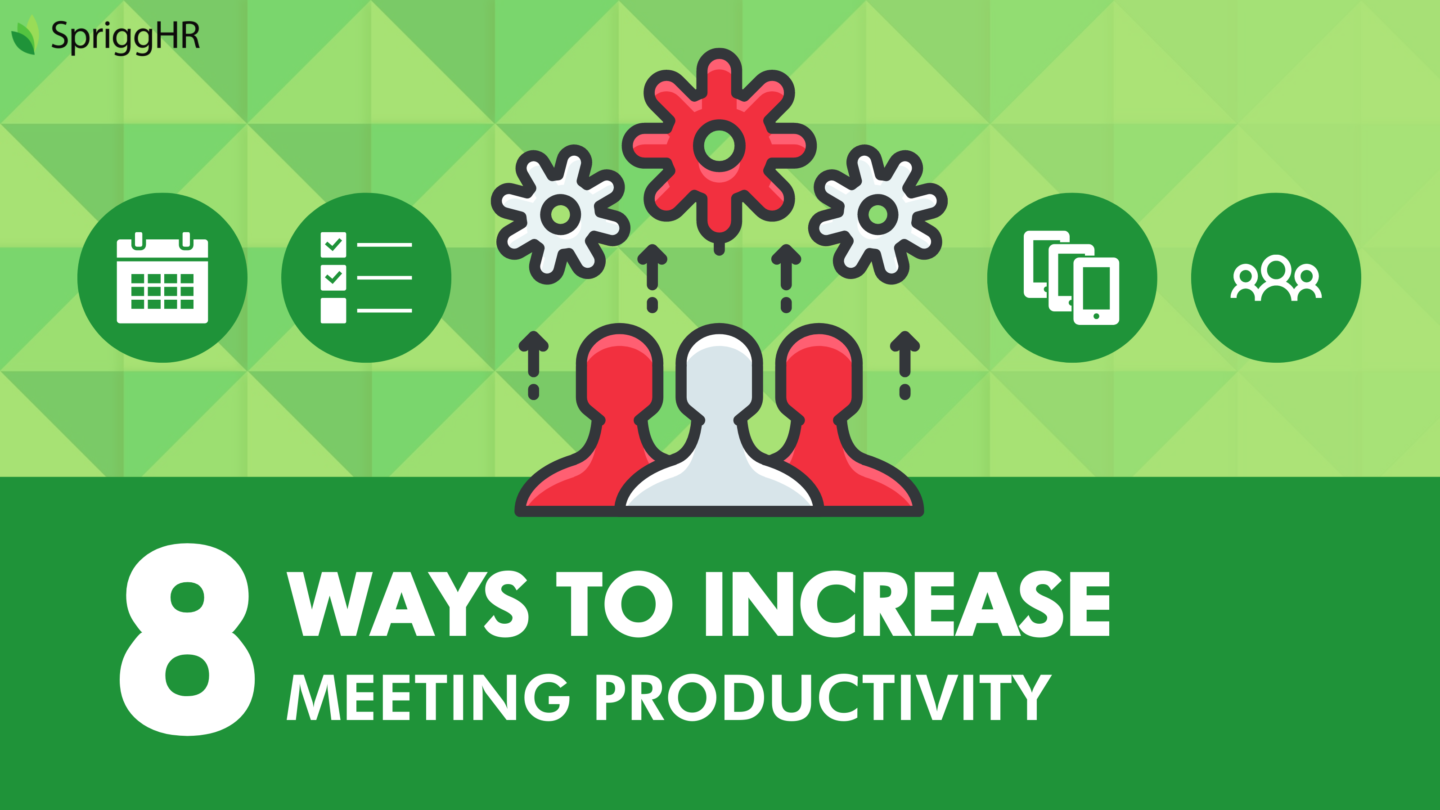
8 Ways to Increase Meeting Productivity
Meeting Productivity or Lack Thereof
Meeting productivity is often given far too little consideration. Bad meetings – those that lack a clear agenda, focus too much on irrelevant topics, conclude without any clear decisions being made, and only help those managers who consistently fail to follow up with action items – are an unfortunately notorious fact of the business world.
Inefficient meetings are more than just a boring experience for your employees – they can also result in massive expenses for your organization. Opportunity costs that result from unproductive meetings arise through salaries and office-related costs, and indirect costs include loss of employee work time, and lower employee satisfaction, which in turn leads to higher employee turnover. Meetings today are almost exclusively virtual, meaning many employees and leaders alike are navigating a way of attending and holding meetings that may be unfamiliar and daunting, which can make productivity even more challenging.
Meeting Productivity by the Numbers
The metrics and statistics pointing to the real-world costs associated with unproductive meetings are all there. In a survey of 182 senior managers conducted by the Harvard Business Review, 65% of participants said that meetings keep them from completing their own work. 71% claimed that their meetings were unproductive and inefficient, 64% said meetings come at the expense of deep thinking, and 62% said meetings miss opportunities to bring the team closer together.
We all know that meetings are essential for enabling collaboration, creativity, and innovation. They provide the opportunity to foster relationships and ensure proper information exchange. These are real benefits but can only actually be achieved when your organization values meeting productivity.
Minimizing unproductive meetings should be a primary aim of your organization. Here are 8 of our best tips to increase meeting productivity, lowering your meeting costs and reducing the time spent on meetings to make them more enjoyable for everyone involved.
1. Time is Not the Real Issue
Increasing your meeting productivity is as much about maximizing energy levels as it is about maximizing time being spent. Many employees are under the stress of not having enough time to complete their assigned tasks, complaining that meetings can rob them of this precious commodity.
To minimize this negative connotation with meetings, consider employee energy levels when deciding the time and duration of your meeting. If you are planning a longer team meeting, work in breaks so that productivity levels are kept at their maximum. While virtual meetings may seem to carry less of an energy toll on your employees, scheduling meetings at the right time remains just as important as if you were to hold them in-person. Work patterns and schedules should remain the same for your employees, and so too should your meeting patterns.
2. Keep Meetings as Short and Concise as Possible
Parkinson’s Law dictates that “work expands so as to fill the time available for its completion.” This holds true for your company meetings. If you schedule an hour-long meeting, your team is likely to fill up this time simply, so they meet the scheduled parameters.
This should be a clear sign that you are not using your meeting time productively. Instead of working to fill up meeting time, aim to keep your meetings as short as concise as possible. This ensures your agenda is kept focused and clear of clutter and filler.
Setting a time limit of 10 or 15 minutes per meeting can really help. Research shows that our attention span only lasts between 10 to 18 minutes. Some organizations even opt for time-tracking activities such as a timer or an incentive to finish on time. Aim to never schedule a meeting that takes up more than 30 minutes. Should you have to, work in a short pause halfway through to keep your staff members’ full attention throughout the meeting. If you find you have run out of time before the clock runs up, do not stretch your babble to fill up space. Rather, ensure all attendees have absorbed all the necessary information, and allow them to return to their individual work.
3. Plan Meetings Only When Needed
Most organizations have a set time and day for meetings. Although consistent and regular check-ins are important to keep your business on track, this runs the risk of slowing productivity altogether. Employees may feel that valuable time is being wasted on mandatory meetings, especially when not many new developments have occurred since the last one, and the meeting is more filler than anything else.
It is much more effective to set up meetings when things need to get done, decisions need to be made, and action points need to be finalized. This reduces the chances of employees feeling they are losing valuable time, and overall increases your organization’s meeting productivity. Weekly, 15-minute meetings are a good rule-of-thumb for many businesses with a lot of moving parts, but if you find your organization stays stagnant in its developments for longer periods of time, try minimizing the frequency of those check-in meetings.

4. Prepare an Agenda
A strong meeting agenda is arguably the most important part of a productive meeting. In fact, most of the time you spend on a meeting should be spent before you even enter the board room or online meeting call.
To develop a good meeting agenda, start by defining why you want to hold the meeting in the first place (establish objectives). Is the meeting even necessary? Or can you communicate your message through other, less time-consuming means, like a simple telephone conference call? While some meetings may benefit from being summarized in an email, there are some outcomes that require a meeting in order to be met. This can include seeking input from coworkers, asking for approval, or passing on vital information.
If you determine the meeting to be necessary, you should then begin to outline what it is you hope to achieve with it. Central to any productive meeting is a clear purpose. In a few words, try to describe the overarching goal of the meeting. Sticking to this throughout the planning process helps eliminate any clutter and time-wasting tangents from occurring.
Next, you need to plan the meeting. To maximize your meeting productivity, it is important to develop an extremely focused and actionable agenda. This means little to no wiggle-room – the meeting will only focus on the items on your agenda, and nothing else. Too much lenience in points of discussion runs the risk of taking the meeting’s intent off track.
Facilitate the meeting! Aim to be specific about the items you are including, avoiding vague topics, and instead of making statements specific to the projects in your organization, asking questions where necessary. It can also be useful to list out the things you don’t want to discuss during the meeting, to ensure everyone is clear about the specific purpose of the meeting.
Before the meeting, send the agenda to all attendees. Clearly explain the purpose of the meeting, details of where it will be held, and what results you hope to achieve from holding the meeting.
5. Create a Smartphone Free Zone
The use of smartphones or tablets during meetings are a nuisance both to meeting leaders and attendees alike. Many agree that it shows not only a lack of respect for the speaker and for their colleagues, but it also displays that full participations are patchy or absent, which can discourage others from being fully present and attentive during meetings.
Making your meeting areas a smartphone free zone, encouraging people to leave phones outside in a basket or at their desks, can help eliminate the potential distractions they cause, ensuring you have full attention from all attendees.
In today’s business world, almost all meetings are being done virtually. While this rule may seem counterintuitive given the reliance upon technology inherent in your meetings today, it still applies. Remote work can be an even more distraction-inducing working style for some employees, and this is only worsened by a lack of control over when they can use their smartphones for non-work-related purposes. Keeping meetings to a smartphone-free time for all team members, even when using technology to hold the meeting still looks to optimize overall productivity.
6. Limit Attendees
One less common tactic employed by companies to boost meeting productivity is limiting the number of attendees invited. Google, one of the most successful companies in the world, is famous for allowing no more than 10 people at a meeting at once.
By limiting attendees and inviting only key people, you are ensuring your meeting stays structured and geared towards the specific outcome you’re after. When you invite too many people, you run the risk of having most of your audience not having clear input and who could be working more productively on their regular tasks.
Limiting attendees is also a strong way to keep your meetings cost-effective. Every employee has an hourly salary – calculating all the hourly salaries of attendees together gives a general hourly price for a meeting. Keeping the number of staff members in a meeting down ultimately lowers your direct costs for running the meeting in the first place.
It is very likely that there are people in your organization who don’t necessarily need to be present at the meeting, but still need to stay in the loop about its outcome. Keeping them updated before and after the meeting is an effective way to keep everyone on the same page without wasting valuable time and resources. On the flip side, it is also likely that there are people who should attend the meeting, but don’t need to be present for the decision making. You should allow these attendees to leave after they’ve presented their points and their presence is no longer required. Looping in additional members may seem easier when holding virtual meetings, but this does diminish the potential it has to hinder the productivity of the meeting overall.

7. Stick to Your Agenda
Meeting productivity hinges upon your ability to, essentially, run the meeting like clockwork. You have your agenda, now you must consistently ensure people follow it when the time comes. To prevent any distractions from cropping up, check with your coworkers beforehand to see if there are any other items that should be discussed during the meeting and include these in your agenda. If topics are proposed that are outside the scope of what you want to accomplish with the meeting, ask them to send a separate memo to the attendees, or propose they schedule a separate meeting with its own agenda.
Productive meetings need to be planned, so your colleagues should have the opportunity to prepare their input before the meeting begins. Making your agenda digitally available to all attendees can help. You can also ask meeting attendees to send short summaries of their contributions to you, so you can have a complete overview of your meeting before it even begins.
To ensure no distractions crop up during the meeting, allot a certain amount of time for each agenda item and/or attendee, clarifying these time limits in the agenda so people can make their contributions as concise as possible.
8. End Your Meeting with Action Items
The final few minutes of any productive meeting should always be allocated to giving a recap of what has been discussed. Aim to ask the following questions at the end of your meetings:
- What are the next steps?
- Who is responsible for them?
- What is the timeframe?
Adjust the timeframe for this reflection period according to the size of your audience. As a rule of thumb, try to use 30 seconds per meeting attendee, to ensure everyone present has a clear answer to these three questions. When a meeting concludes, everyone should have a clear understanding of their responsibilities, and are accountable to other meeting attendees.
Once the meeting is complete, send out a summary of the minutes, along with specific action items you discussed at the end of the meeting. Tag each of these action points to the DRI (Directly Responsible Individual). This way, you ensure that the meeting outcome is achieved.
Start Increasing Your Meeting Productivity Today
Meeting productivity is central to any organization’s overall success. Inefficient meetings run the risk not only of costing your company valuable time and money, but of also decreasing overall morale in the workplace. Productive meetings work to reduce these risks, maximizing the benefits of meetings, and encouraging organization-wide collaboration, creativity, and innovation.




